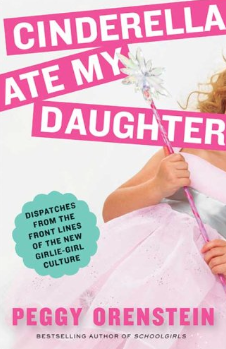On the heels of Halloween, with the multitude of princess costumes that surely flooded the streets in all corners of this country, I can think of no better book to reference than this one.
Let me say first, I loved this book and my copy is almost entirely underlined. To paint a brief picture, I’ll choose one of those powerful snippets, “even as new educational and professional opportunities unfurl before my daughter, and her peers, so does the path that encourages them to equate identity with image, self-expression with appearance, femininity with performance, pleasure with pleasing, and sexuality with sexualization.”
Orenstein examines a specific niche of the many challenges of raising a girl in the modern, capitalist driven American culture we live in today. She tracks developmental stages alongside of marketing campaigns targeted at them and their long-term outcomes on esteem and self-concept. She explains how the sexualization of toys and the culture directed at young girls, leads to a fixation on appearing somewhere on the desirable/approved–sexy spectrum, and simultaneously disconnects girls from their own emotional exploration around desire and self-satisfaction. In this way, the goal becomes external approval and external satisfaction. This is the beginning of a series of trap doors that follow young women throughout their development, often leading to high levels of anxiety, depression and certainly eating disorders to name a few.
All of that and not to mention really murky territory when it comes to development of sexual empowerment later in life. Here is another choice snippet by Deborah Tolman to illustrate the risk, “they [teenage girls] respond to questions about how their bodies feel- questions about sexuality and arousal- by describing how they think they should look. I have to remind them that looking good is not a feeling.” That quote gives me chills. It is a frightening abdication from one’s sense of self to confuse internal feelings of one’s own experience with external assessments of how one appears to the outside lens (which we might add, is then ever changing).
Luckily, it’s not all gloom and doom. Along with bigger more radical steps, this book also illuminates many simple parenting approaches to help buffer these influences. One that may ring controversial, is that yes, it is okay to tell your daughter she is beautiful. The key is to tell her when she is crying, when she is sweaty after a soccer game, when she speaks up to a friend, when she has her first heartbreak. Orenstein says, “it is important to connect beauty and love…Everything about you is beautiful to me- you are beautiful to me. That way you are not just objectifying her body.”
Orenstein brings the reader along as she navigates her experience with her own daughter with humility and humor. This book is valuable to anyone helping to raise, influence, role model or connect with a young girl in today’s world.
*It should be noted that Orenstein writes in reference to the cisgender, straight, young female population.
